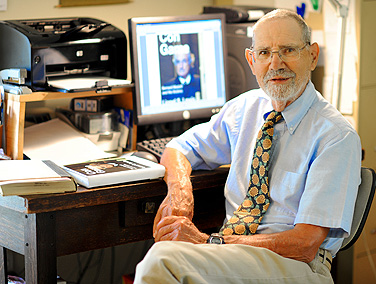News
Madoff conned victims, sociologist says

While Bernard Madoff’s crime is universally referred to as a Ponzi scheme, Lionel Lewis calls it “a con game, pure and simple. It was an attempt to make something that is not reality appear to be reality.”
Bernard Madoff’s fraudulent investment firm was responsible for emotional damages that often were as painful as the financial losses.
Madoff used a Ponzi scheme to cheat thousands of people out of billions of dollars. Yet, the money speaks mostly to the mechanism of the crime. And looking exclusively at the balance sheet provides little insight into the victims’ perspective.
Now, a book being published this month by UB sociologist Lionel S. Lewis examines the depth and various dimensions of the crime’s aftermath to discover how the largest investment fraud in U.S. history affected its victims.
Madoff pleaded guilty to multiple federal felony charges in 2009 and is serving a 150-year prison sentence.
His crime is universally described as a Ponzi scheme, a white-collar crime that uses funds from initial investors to pay later investors. But to understand the effect on the victims, it is necessary to examine the context of the crime. In his new book, “Con Game: Bernard Madoff and His Victims,” Lewis, professor emeritus in the Department of Sociology, says the Ponzi scheme was merely Madoff’s tool, not his trade.
“Everyone talks about Madoff’s Ponzi scheme,” says Lewis. “But this was a con game, pure and simple. It was an attempt to make something that is not reality appear to be reality.”
Trying to understand a victim’s feelings by restricting the crime’s emotional focus to its Ponzi scheme is like a visitor to the Louvre trying to understand a painter’s output by looking only at the artist’s brush. Lewis says it’s critical to see Madoff as the inside man in an elaborate decades-long drama where he maintained a fake office and pretended to trade stock.
“It was like a play,” he says. “It involved acting and props.”
Lewis examines Madoff’s fraud as a con game because doing so provides him with a set of conceptual tools. Cons have established roles: inside men, outside men (those who set up the victim), ropers and victims. Driven by greed, victims are brought into the enterprise by ropers, who subsequently give money to the inside man. Madoff’s plot line, in fact, is similar to that of the motion picture “The Sting.”
“It was very elaborate, with specific machinery,” Lewis notes. “Ten people were helping—programming computers, backdating trades and producing a lot of paper based on fraud.”
Some victims were financially crushed by the fraud, but in certain cases, what might appear to be a significant individual loss represented a small percentage of a victim’s total wealth. For example, from Palm Beach, Fla., alone there were a number of multi-millionaires. The anger in these instances was in large part generated by embarrassment, Lewis says.
Many of the victims, he points out, were successful and prominent people who had to admit to a degree of greed and foolishness for having bought into the con, but they went to great lengths to try and deny it.
When many victims learned that their money was stolen, they were stunned, Lewis says, adding that some formed an exclusive community to give themselves a voice—joining support groups, blogging, calling government officials and giving statements to media.
First, he explains, they blamed Madoff. Then they blamed the government. Victims then moved to the court-appointed trustee who was trying to help recover their stolen money. They did everything but accept responsibility for their loss, Lewis says. They denied being part of a con game and merely wanted the money that Madoff invested back—they wanted to be made whole. But there were no investments to begin with and, consequently, no money to return.
Lewis says that more than 165 victims wrote to the judge asking that Madoff be given the harshest sentence. During his sentencing, a group of victims wanted to publicly humiliate him. Those in the courtroom witnessed more theatre, a classic case of ritual degradation.
The residual anger of victims is, curiously, the result of one of the flaws in Madoff’s con. As odd as it may seem to discuss customer service in the context of a fraudulent business, that shortcoming can be blamed for much of the angry reaction, according to Lewis.
“After the con, there was no one to cool these victims out, no one to let them down gently,” he says. “The victims faced adverse legal decisions and less compassion from the public and media than they felt they deserved.
“There is some ambivalence among the victims. On the one hand, they want to go public and get help and sympathy. On the other hand, they don’t want anyone to know that they had been duped,” he says.
Although Madoff insisted he acted alone, he clearly didn’t, Lewis notes.
“I would like to get inside the con,” Lewis says. “As the dust continues to settle, more can be learned about the con as we learn more about those who assisted Madoff in running the con game.”

Reader Comments